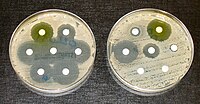
Photo from wikipedia
The emergence of antimicrobial resistance of Gram-negative pathogens has become a worldwide crisis. The status quo for combating resistance is to employ synergistic combinations of antibiotics. Faced with this fast-approaching… Click to show full abstract
The emergence of antimicrobial resistance of Gram-negative pathogens has become a worldwide crisis. The status quo for combating resistance is to employ synergistic combinations of antibiotics. Faced with this fast-approaching post-antibiotic era, it is critical that we devise strategies to prolong and maximize the clinical efficacy of existing antibiotics. Unfortunately, reports of extremely drug-resistant (XDR) Gram-negative pathogens have become more common. Combining antibiotics such as polymyxin B or the broad-spectrum tetracycline and minocycline with various FDA-approved non-antibiotic drugs have emerged as a novel combination strategy against otherwise untreatable XDR pathogens. This review surveys the available literature on the potential benefits of employing antibiotic-non-antibiotic drug combination therapy. The apex of this review highlights the clinical utility of this novel therapeutic strategy for combating infections caused by 'superbugs'.
Journal Title: Essays in biochemistry
Year Published: 2017
Link to full text (if available)
Share on Social Media: Sign Up to like & get
recommendations!